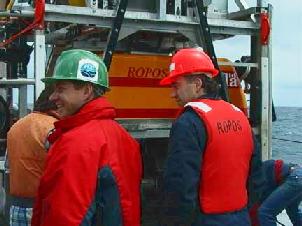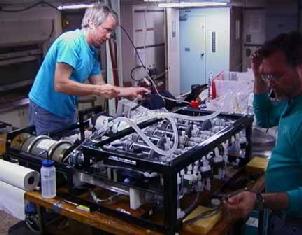WHAT'S NEW:
BACKGROUND:
Mission
Project Description
Cruise Plans:
Participants
Technology (ROV, ships, etc.)
Future Plans
Results:
1998 NeMO Cruise
Axial 1998 "Eruption"
Logbook
June 29, 1999
June 29, 1999
Contents:
- News from Thompson
- Participant Perspective
- Logbook from Teacher at Sea
- Question/Answer from shore to sea
Thompson Science Report
Science Report - Tuesday, June 29
Ships Location: 45 55.9/129 58.9

Keith Sheperd and Craig Elder working on ROPOS before dive 491. |
Listing of all Science News postings
Life at Sea: Participant Perspective
Morgan Turrell
Chief Officer,
Thomas G. Thompson
 As another crew
member aboard the Thompson, I am lucky to be a shipmate
with some great people. Without some of these quality individuals,
my job would be more difficult. Safety is my primary objective.
As another crew
member aboard the Thompson, I am lucky to be a shipmate
with some great people. Without some of these quality individuals,
my job would be more difficult. Safety is my primary objective.
I used to work on commercial cargo ships. For a year now, Ive been on the Thompson. The change has been rewarding. Each trip is different so there are new challenges and I enjoy watching science in action. Working with so many scientists from unique backgrounds makes each trip memorable. As a sailor I have learned so much about the environment from our work out here. With ROVs and new high-tech instruments, I am watching technology uncover an ocean I took for granted.
People and technology are inseparable out here. One couldn't exist without the other. Without the marvelous satellite and digital technology, our crew couldnt get the ship and scientists to precise locations, yet without the scientific curiosity, the technology would be useless. I learn something new everyday.
On the Thompson, everyone is both a student and a teacher. Captain Games, our crew and the scientists have made learning fun and I thank them.
Listing of all Perspectives postings
Teacher At Sea Logbook
Teacher Log #9 6/29/99
With calmer seas and high expectations of a day diving to the sea floor, we began our tenth day at sea. ROPOS is now in the water for it second time today. During the first attempt toady, it was back on deck within an hour due to difficulties with the color video camera necessary for viewing the bottom. During the day I had the opportunity to visit with David Butterfield about one of the more important pieces of equipment, the Hot Fluid Sampler.
 Dave Butterfield making adjustments to the HFS. |
With a researcher at the controls, the probe is placed within the specific vent location. As a sample of vent fluid is drawn through the main sample line by the flushing pump, the temperature of the incoming fluid is determined. It continues through the pipeline of the system until it comes to a junction. At this time it is again measured for temperature. This second temperature reading is important to determine if the sample being taken is most vent fluid or a mixture of sea water and vent fluid. The smaller the difference in temperature the higher the probability it is a good quality vent fluid sample. Temperature can also be important in dealing with extremely hot vent fluids. If the sample is too hot, the collecting jars can melt. When it is determined that the incoming fluid is probably a high quality sample, the command is given via a computer signal to collect it. The incoming sample can be either collected into one of six piston samplers, diverted to one of eight collecting bags, or sent to one of ten independent filters. After the sample has been collected, It can also be determined just how much fluid was collected. The sampling pump is then turned off . This flushing pump helps to keep the lines clear of debris as well as to help keep one sample from contaminating another. Congratulations to Dave and all those who helped in taking this idea and turning it into a reality.
Good news for all aboard, ROPOS has reached the bottom and will
hopefully have a good dive. Highlights tomorrow as well as a visit around
the ship. Stay Tuned.
Bye for now.
Logbook of all Teacher At Sea postings
Questions & Answers
Questions:
From the audience at the HMSC Public Wing's daily lectures on NeMO by Steve Babcock, NeMO teacher-on-shore
(lectures are daily at noon and 3:00pm during the Thompson/ROPOS cruise)
What is the chain of command on board with regards to the dive plan?
The dive plan is outlined by the Chief Scientist for the cruise, Dr. Bob Embley. Each day there is a science staff meeting where the plan is gone over and modifications are made to maximize the work that ROPOS is configured for.
If problems occur with ROPOS, who decides which experiments will be scrubbed?
Dr. Embley has the final say when problems and or differences of opinion occur. You'll find him throughout most dives keeping and eye out for any problems but also for any new things or directions the in the dive plan.
Are they (scientific objectives) prioritized before sailing?
Before the cruise a definite set of goals are set up and prioritized. But once at the site, as we have found out this cruise, plans do change. The overall goals are maintained, but the specific order in which they are achieved may change. Each dive presents new challenges and adjustments are made accordingly.
For long-term observatory could you power your monitoring systems with hydrothermal energy from the vents?
This is a good idea, and experiments have been done with harnessing hydrothermal energy. The problem is that high temperature vents are constantly precipitating sulfide minerals as the vent fluid quickly cools in the cold bottom water. This is how black smoker chimneys form - the chimneys are made out of sulfide minerals that come out of the vent fluid. Because of this continuous mineral precipitation, this idea is not feasible due to the extremely corrosive environment. Also, equipment would be quickly fouled and maintenance would be impossible. As for powering the equipment now, electric power is provided from the ship to ROPOS through the cable that lowers it to the bottom. Any autonomous vehicle (not connected to a ship) is powered by batteries.
How does this project relate to NOAA's work on Tsunamis? Will knowledge of ocean bottom displacement as gained by NeMO be used to help Tsunami modeling?
Several technological elements that are being used in the NeMO project were originally developed as part of NOAA's tsunami project. Bottom pressure recorders are used to detect tsunamis in the open ocean and are also used in NeMO's rumbleometer, like the one that recorded a 3m subsidence in the caldera last year or the one stuck in the lava flow. Data is shared between the two programs. In addition, the mooring and surface buoy that we plan to deploy at Axial in September to enable daily transmission of data from the seafloor to shore is a direct outgrowth of technological developments in NOAA's Tsunami and TOGA-TAO projects.
All Questions/Answers from sea
![]() Send Your Question to NeMO
Send Your Question to NeMO
(oar.pmel.vents.webmaster@noaa.gov)